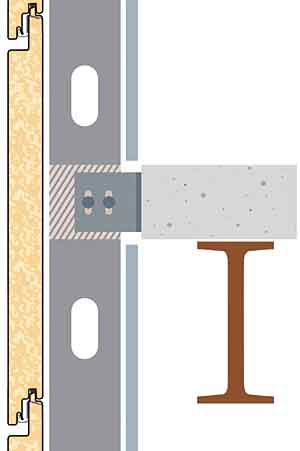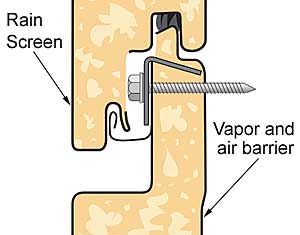Thermal and Moisture Control in Exterior Metal Walls
Superior Wall System 2: Single Component
This system is a factory-assembled composite foam panel system
built as the entire
wall system (Figure 19). It is intended to be secured directly
to the building structure. It provides a fully integrated
approach to providing a weathering surface, vapor retarder,
water infiltration barrier, and air infiltration barrier.
Key benefits of this single component system include:
- Pre-finished exterior weather surface in manufacturer's selection of colors and finishes
- Integral water barrier by virtue of the sealed system materials.
- Integral air barrier sealed at all required locations.
- Integral vapor retarder by virtue of the sealed and finished interior surface.
- Insulation at various levels as needed for differing climates, as indicated in ASHRAE.
- Greater R-values than metal stud cavity insulation.
|
As indicated earlier in the rainscreen definition section, proper design of the horizontal joint can create pressure equalization.
This wall system has been tested using both the static and dynamic water tests. The tests results are excellent. With the interior sealant intermittently removed and at a 15 psf test pressure, there is no water infiltration. Intermittent removal of the sealant testing is consistent with the previous test protocol of testing with an imperfect air barrier.
Superior Wall Design Recommendations
The two superior performing wall systems presented eliminate
layers of components thereby minimizing scrap and labor. Other
building material factors to consider during the design phase
are the following:
- Establish air, water and vapor barriers behind the rainscreen
- Establish an air space behind the rainscreen
- Drain the air space at panel base, window, and door heads
- Establish perimeter trim seals to air and water barrier
- Use the right material in the right location
- Avoid materials with mold food
|
Window Selection
When selecting windows follow these guidelines:
- Use a window that integrate into the wall system
- Require testing to documented performance
- Tie window into the wall system air barrier
Risk Management
Multi component wall systems are complex to design and difficult
to properly install. When designing exterior metal wall systems,
consider reducing risk by:
- Limiting the number of suppliers and trades involved in the wall design and assembly.
- Using elements as rainscreens that have been tested with imperfect air barriers.
- Eliminating multiple component backup systems by using an insulated composite panel.
- Use a factory assembled composite foam panel system wherever possible.
Moisture management is key to a successful wall system. It is best achieved when a building is designed to meet the proper environmental criteria.










